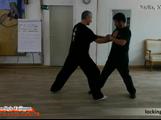Workshop Practical Method Chen Style Taichi Quan push hands by Grandmaster Joseph Chen Zhonghua
De Glind 26-27april 2014, Netherlands
These notes are partly chronological and based on how I percieved them. I kept as close as I could to Master Chen’s exact words.
Day one
The workshop started with an introduction. Underlying the art of Practical Method Taiji Chen Style are thirteen dimensions. These thirteen dimensions are divided in two levels. Eight dimensions are related to the air; five are related to the floor.
Dimension one is movement versus no movement
Dimension two is speed versus time, etcetera
Every practiotioner of this art is acting on a certain level. We learn Practical Method from end to beginning.
Step 1 is Don’t move
Step 2 is rotate
Step 3 is kua
So first we learn opening the kua. Then we take away the concept of believe out of taiji by learning rotations. Step one ‘don’t move’ we learn thirdly.
While performing in level one we learn to use of the following power and direction: (vectors) |->| |<-| |<->| |-><-|
When we master this we learn to use diagonal vestors in the body.
Action versus slack. An action is a proportional internal stretching. Slack is movement without following principles of internal move; say wobbling.
All movements in PM are stretches; a ‘pung energy’. Pung energy got no handle (Zhuofa).’ The extension is inside the practitioners body. By imagining a dot on the body of the opponent you can meet his power. Bringing this point outside the opponent you can guide his power.
Four step excersize: holding hand. By stretching the hand bringin it in line with the lower arm.
Bring the elbow in a line to the dantian. Then rotate before your body. Tip: bring the ellbow far in and imagine your power is generated by stretching the power coming from your ellbow in one line.
Excersize: opening of the shoulder. Bring your shoulder in like in positive circle. Get your ellbow with your other arm and bring/push/pull the ellbow tot he other side of the torso, without raising the shoulder.
Front kua is allways higher then the rear kua.
Excersize: defend being pushed against the wall. Imagine one dot on your opponent and defend with only one positive or negative circle.
Day two
Push hands excersize: opponent makes one attack. Make 5 contact points by adding one at the time. Push opponent easily out of balance with additition of fith contact point.
Push like a stick, pull like a rope.
Excersize: closing doorhinge. Meeting attack. Sink down. Bypassing arm on the opponent (hand pushing contact, ellbow not pushing contact/tendency away from opponent, shoulder pushing contact, armpit not pushing contact, kua pushing, leg not pushing). Now push your hand outside, around opponent and pivot on front foot and don’t move front knee and kua (arm same speed, not faster then leg= doorhinge principle).
Excersize: positive circle 1) far in with ellbow 2) link up kua, ellbow and hand 3) out with hand around opponent
Excersize: negative circle 1) in with ellbow 2) turn waist 3)out with hand.
Chinese translation for training is grinding, forging.



